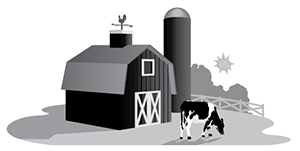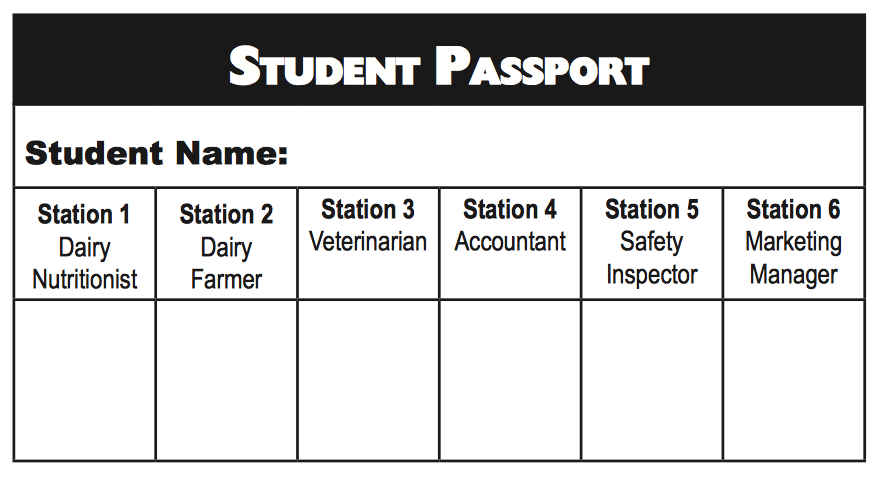Agricultural Literacy Curriculum Matrix
Lesson Plan
Milk Makin' Math
Grade Level
Purpose
Students explore the numerous career opportunities involved in the dairy industry and solve real world math problems related to specific careers within the industry. Grades 3-5
Estimated Time
Materials Needed
- Milk Makin' Math Activity Book for each student
- Milk Makin' Math Answer Key
- Large piece of paper & markers for each group
- One-dollar bill
- Checkbook or sample of a check
- One or more photos showing the inside of a milk barn
- Feed Samples (optional)
- Syringe with needle removed
- Digital Scale
- Gallon of milk
Vocabulary
accountant: a professional who keeps records of business-related financial transactions
dairy farmer: a farmer who specializes in raising dairy cattle, specifically for milk and/or cheese products
dairy nutritionist: an animal health professional who specializes in the nutritional needs of dairy cows; nutritionists recommend the best diets for cows and monitor how cows respond to their feeding program
marketing manager: advertises, promotes, and sells products to distributors, processing plants, and eventually, to the public
safety inspector: helps prevent harm to workers, property, the environment and the general public; makes sure the dairy products we consume are safe and healthy to eat; also makes sure the food we eat is free from germs and stored at the correct temperature
veterinarian: a doctor who treats animals
Background Agricultural Connections
This lesson is part of a series called, Milk Matters: Discovering Dairy. These lessons introduce students to the history, production, nutritional value and economic significance of the dairy industry. Other related lessons include:
- Cowabunga! All About Breeds
- Sun, to Moo, to You
- Milk Makin' Math
- The Ultimate Efficient Recycler
- A Day Without Dairy
Dairy careers require a variety of skills, including skills in science, technology, reading, writing and mathematics. This lesson features real-life math challenges that individuals working in the dairy industry face everyday. Students will make important connections between the math problems completed in school and the math skills essential to employment. Students will study the career fields of a safety inspector, marketing manager, accountant, veterinarian, and dairy nutritionist.
More background information on the dairy industry can be found here.
Engage
- Draw! Give students markers and a large white sheet of paper, and three minutes to brainstorm dairy-related careers. Working in groups, students draw as many images as possible representing careers found on a dairy.
- Encourage students to share their drawings with the entire class. Create a master list of careers on the board and brainstorm important skills these individuals need to be successful with their jobs.
- Discuss and emphasize how math skills are essential for all jobs, including work on a dairy.
Explore and Explain
- For this lesson, groups of students (determined by the teacher) will rotate between six different learning stations. Each station should be set up with one table and chairs for each student in the group. Each station will focus on a different dairy career. Students will move around the room, completing math challenges found in each student’s Milk Makin’ Math Activity Book. Set up each of the stations as follows:
- Station 1: Dairy Nutritionist
Visual: Samples of hay, dairy feed components. With each sample, include a label and definition - Station 2: Dairy Farmer
Visual: One or more photos showing the inside of a milking barn. - Station 3: Veterinarian
Visual: A syringe with the needle removed. - Station 4: Accountant
Visual: A checkbook to represent expenses and a dollar to represent profit. Using index cards, define and label each as profit or expense. - Station 5: Safety Inspector
Visual: A large weather thermometer that shows temperature in degrees Fahrenheit. - Station 6: Marketing Manager
Visual: Place one gallon of milk on a digital scale.
- Station 1: Dairy Nutritionist
- Instruct students who complete stations early to illustrate the cover of their activity book.
- Review the answers to the problems with the entire class. Conclude the lesson with a class discussion on:
- What are your impressions on the amount of math needed to be successful in your career?
- Which career would you enjoy most? Why?
- Which job is the most difficult? Why?
- Which job is the easiest? Why?
- On an index card, students write down one fact they learned about one of the possible dairy careers. Students will use this “ticket” to be excused for lunch, recess or a nutrition break.

Variations:
- Students move around the stations in pairs. Students complete each math challenge together.
- Students create a dairy “passport.” With each completed station, they receive a stamp to show their success.

- Students complete a KWL chart to begin the lesson.
Elaborate
- Visit the Interactive Map Project website and view the Dairy Cattle Inventory map. As a class identify the highest milk producing states and discuss the factors which could contribute to the success of dairy farms such as climate, open space, etc. Identify where your state ranks in dairy cattle production and discuss the factors contributing to the statistic.
- Invite individuals representing dairy careers to sit on a panel for the class. Students have the opportunity to learn about each of the careers by asking questions of each guest speaker.
- Invite individuals from each dairy career to monitor activity stations.
- Students work in groups to research each dairy career. This activity may include interviewing employees in the industry, researching online or role-playing job responsibilities.
Evaluate
After conducting the following activities, review and summarize the following key concepts:
- There are many careers related to dairy farming.
- Agriculture is responsible for producing the most important necessities for daily living including food, fiber, and shelter.
- Dairy farms produce milk, but they also provide many different jobs.
Acknowledgements
This lesson was funded in 2008 by the California Milk Advisory Board and the California Farm Bureau Federation. To meet the needs of California educators, Milk Matters: Discovering Dairy was created to meet the Curriculum Content Standards for California Public Schools. The unit also includes a collection of relevant resources about the dairy industry.
Executive Director: Judy Culbertson
Layout and Design: Imelda Muziom
Recommended Companion Resources
- Anno's Magic Seeds
- Better Butter
- Biotech Cheese Kit
- Chuck's Ice Cream Wish (Tales of the Dairy Godmother)
- Dairy Reader
- Dairy Tour 360
- Dairy in the Mountain West: Our Family of Farmers
- Discover Dairy
- Eating Fractions
- Ice Cream: The Full Scoop
- Make Mine Ice Cream
- Make Mine Milk
- Moo 2 You (DVD)
- NMSU Field Trip: Milk
- One Grain of Rice
- The Journey of Milk
- The Things You'll Grow: Agriculture Careers for Little Big Dreamers
Author
Organization
| We welcome your feedback! If you have a question about this lesson or would like to report a broken link, please send us an email. If you have used this lesson and are willing to share your experience, we will provide you with a coupon code for 10% off your next purchase at AgClassroomStore. |
